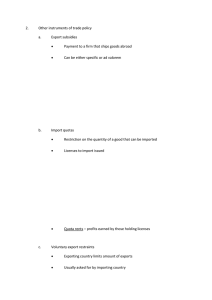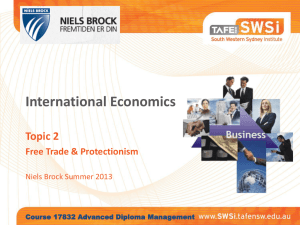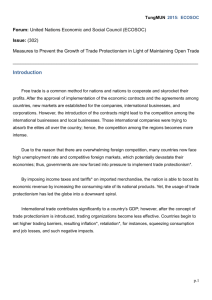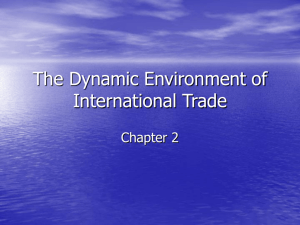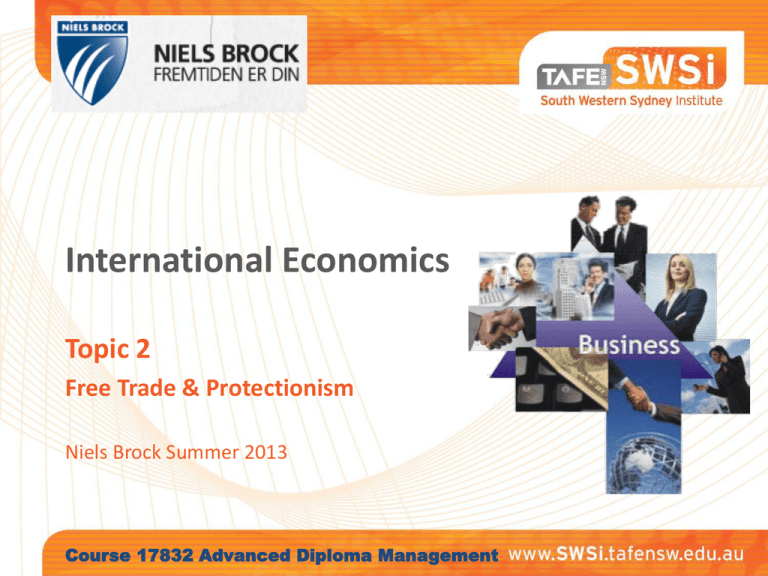
International Economics
Topic 2
Free Trade & Protectionism
Niels Brock Summer 2013
Course 17832 Advanced Diploma Management
Free trade, fair trade and
strategic trade
• Economists argue that international trade should be
based on comparative advantage and free trade.
• Free trade is the flow of goods and services between
countries without restrictions or special taxes
• Fair trade is the flow of goods and services with countries
that do not have an ‘unfair’ competitive advantages (and is
also willing to reduce trade barriers).
• There is an alternative definition of “fair trade” (i.e. nonexploitation of developing economies) which will be
discussed in the next few weeks.
• Strategic trade is where governments facilitate certain
sectors of the economy and industries that have export
potential
2
Benefits of free trade
• Free trade helps to bring lower prices,
greater choice for consumers and lower
input prices for firms using imported factors.
• Higher spending power within the economy
may also stimulate growth in other
industries.
• But…moving towards free trade may have
short-term adjustment problems.
3
Arguments for free
trade
• Provide consumers with lower prices
• Extra buying powers of consumers stimulates
growth in other areas of the domestic economy
(with the resulting increase in employment,
investment etc.)
• Allows local industries to purchase raw materials
and intermediate goods more cheaply, lowering
the cost of production, thus making the end price
of goods more competitive on the domestic and
international market (lower input prices)
Arguments against free
trade
• Puts local industries out of business as they
cannot compete on price (higher labour costs)
• May reduce income of employees, or lead to
job loss (with consequent impact on
consumption, prices and employment)
Protectionism
Protectionism
uses restrictions
to protect
domestic
producers from
foreign
competition,
including
Embargoes: laws that bar
trade with another country.
Tariffs: taxes on imports.
Quotas: limits on the
quantity of a good that may
be imported (variation is
voluntary export restraint)
6
More forms of
protectionism
• Other forms of protectionism are export subsidies
and product standard requirements
• Subsidies are grants or other funding given to
firms or industries that compete with imported
goods to allow them to keep input costs and
prices down.
• Product standards provide restrictive rules on
imported goods such as safety requirements,
product features, and packaging requirements
(which may increase input costs due to “red
tape”)
Protectionism reduces international trade
Arguments for
protectionism
• Protecting employment in industries affected by foreign competition
• To compete with countries that use anti-competitive “cheap labour”
• Protecting new or ‘infant’ (sunrise) industries, which have not yet grown
to a size big enough to allow them to compete
• To avoid the risks of over-specialisation, so as not to be over-dependent on
the export of one or two products
• Maintaining industries which are considered strategic, e.g. food supplies,
defence supplies, energy supplies (sometimes called the “national security”
argument)
• reducing imports in order to improve a weak balance-of payments position
• retaliating against those countries which protect their industries and
markets
• To increase government revenue (increasing tariffs means increasing tax
income for the government)
Arguments for
protectionism
• preventing dumping; dumping is the selling of goods, by foreign
producers, at prices below the cost of production; this may be done to
gain a foothold in new markets or to get rid of surpluses
• helping the environment, e.g. banning the import of hardwoods from
tropical rain forests; products from rare animals, e.g. rhino horn, furs.
• To protect product standards
• protecting consumers from harmful products, e.g. illegal drugs,
dangerous animals, poor quality foods etc.
• exerting political pressure, e.g. the US embargo on Cuba, UN embargo
on Iran
These arguments are especially strong during times of economic decline
(pressure on jobs and failing companies/industries etc. due to economic
downturn)
All of these arguments only receive weak support from economists as
ANY intervention into the market creates inefficiency
Arguments against
protectionism
• Supports industries that are not economically
viable or efficient
• Less consumer choice
• Reduces competition
• Increases prices
• Distorts comparative advantage (reduces
specialisation and thus world output)
• May result in “retaliation” from other
countries (reducing export potential)
Activity
Student workpoint 22.1, p. 270 of textbook
Article: EU imposes long-term tariffs on Asian shoes
In groups, answer the following
1. Define dumping
2. Outline the arguments for and against the European
imposition of tariffs on Chinese and Vietnamese
shoes
Present your findings to the class
Activity
Student workpoint 22.2, p.271 of text
RESEARCH – Environmental standards as a
barrier
Discuss in your groups then share with the class
Discussion
• Who is advantaged and who is disadvantaged
by the introduction of the following
protectionist measures:
– Tariffs
– Subsidies
– Quotas
– Embargoes
– Product standard requirements
Consider why each of these parties advantaged or
disadvantaged
Clips
•
•
•
•
•
•
•
http://www.youtube.com/watch?v=9rgdahE5t3o
http://www.youtube.com/watch?v=GCnrd7NW9r8
http://www.youtube.com/watch?v=iUAeumFSFS8
http://www.youtube.com/watch?v=cFUPSDUOiQg
http://www.youtube.com/watch?v=bfE2HO8p3FE
http://www.youtube.com/watch?v=7njIlZ2xYq0
http://www.youtube.com/watch?v=0EwfuVqp1fM&fea
ture=related
Innovation
sixth sense tech
• http://www.ted.com/talks/pranav_mistry
_the_thrilling_potential_of_sixthsense_te
chnology.html
• When was this posted?
• It is freely available tech as open-source!
• Discussion
– tech developed efficiently and to last
EFFECT ON AGGREGATE SUPPLY AND
DEMAND FROM PROTECTIONISM
Culbertson Article (HBR)
Questions to consider
1. Why does Culbertson argue that international trade IS NOT governed by
comparative advantage ? (p.124) Do you find this argument compelling?
Why or why not?
2. Is cost-cutting possible to assist countries to compete internationally and
does it produce efficiencies in the market?
3. How valid do you think his argument is for not allowing developing
countries free access to the US market?
4. What are the key recommendations about US trade policy (for 1986
hence). Is this what you would recommend? Why or why not?
5. What is the key message from this article?
6. Are these arguments as valid today as in 1986? Why or why not?
The effect of
protectionism
• Various forms of protectionism will shift the
shift the supply curve
• You will see from the Blink and Dorton
handout that there is:
– a shift along the curve with tariffs (due to simple
change in price)
– A shift in the supply curves for subsidies and
quotas
Costs and Benefits of
Tariffs
• A tariff raises the price of a good in the importing
country, making its consumer surplus decrease
(making its consumers worse off) and making its
producer surplus increase (making its producers
better off).
• Also, government revenue will increase.
8-19
Costs and Benefits of
Tariffs (cont.)
8-20
Costs and Benefits of
Tariffs (cont.)
• For a “large” country that can affect foreign (world) prices, the
welfare effect of a tariff is ambiguous.
• The triangles b and d represent the efficiency loss.
– The tariff distorts production and consumption decisions: producers
produce too much and consumers consume too little compared to the
market outcome.
• The rectangle e represents the terms of trade gain.
– The terms of trade increases because the tariff lowers foreign export
(domestic import) prices.
8-21
Costs and Benefits of
Tariffs (cont.)
• Government revenue from the tariff equals the
tariff rate times the quantity of imports.
– t = PT – P*T
– QT = D2 – S2
– Government revenue = t x QT = c + e
• Part of government revenue (rectangle e)
represents the terms of trade gain, and part
(rectangle c) represents part of the value of lost
consumer surplus.
– The government gains at the expense of consumers and
foreigners.
8-22
Costs and Benefits of
Tariffs (cont.)
• If the terms of trade gain exceeds the efficiency loss,
then national welfare will increase under a tariff, at
the expense of foreign countries.
– However, this analysis assumes that the terms of trade
does not change due to tariff changes by foreign countries
(i.e., due to retaliation).
8-23
Costs and Benefits of
Tariffs (cont.)
8-24
Subsidies
• Where subsidies are paid to local firms to
make them more competitive in the local
market the domestic supply curve will shift
downwards by the amount of the subsidy.
• (See Blink and Dorton summary for S+D
curves)
Export Subsidy
• An export subsidy can also be specific or ad valorem
– A specific subsidy is a payment per unit exported.
– An ad valorem subsidy is a payment as a proportion of the value
exported.
• An export subsidy raises the price of a good in the exporting
country, making its consumer surplus decrease (making its
consumers worse off) and making its producer surplus
increase (making its producers better off).
• Also, government revenue will decrease.
8-26
Export Subsidy (cont.)
• An export subsidy raises the price of a good in the
exporting country, while lowering it in foreign
countries.
• In contrast to a tariff, an export subsidy worsens the
terms of trade by lowering the price of domestic
products in world markets.
8-27
Copyright © 2006
Pearson AddisonWesley. All rights
reserved.
Export
Subsidy
(cont.)
8-28
Import Quota
• An import quota is a restriction on the quantity of a
good that may be imported.
• This restriction is usually enforced by issuing licenses
to domestic firms that import, or in some cases to
foreign governments of exporting countries.
• A binding import quota will push up the price of the
import because the quantity demanded will exceed
the quantity supplied by domestic producers and
from imports.
8-29
Import Quota (cont.)
• When a quota instead of a tariff is used to restrict
imports, the government receives no revenue.
– Instead, the revenue from selling imports at high prices
goes to quota license holders: either domestic firms or
foreign governments.
– These extra revenues are called quota rents.
8-30
Copyright © 2006
Pearson AddisonWesley. All rights
reserved.
US Import
Quota
on Sugar
8-31
Voluntary Export
Restraint
• A voluntary export restraint works like an import
quota, except that the quota is imposed by the
exporting country rather than the importing country.
• However, these restraints are usually requested by
the importing country.
• The profits or rents from this policy are earned by
foreign governments or foreign producers.
– Foreigners sell a restricted quantity at an increased price.
8-32
Homework for next
week
• Read chapter 23 of Blink and Dorton (2011)
• Attempt the activities in the Chapter
Next week
• Free trade agreements
• International trade organisations
Thank You!
• Coming weeks
– Topic 3, Ch 23:
– Exchange Rates
35


